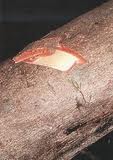 |
| Chuchuhuasi bark |
In the Amazon, products purporting to enhance male sexual potency are sold in stalls and shops all over the jungle. These drinks are probably as well known for their names as for their ingredients — Rompecalzón, Rip-Your-Shorts; Levántate Lázaro, Arise Lazarus!; Para Para, Stand up! Stand up!; Tumba Hembra, Knock Her Over; Siete Veces Sin Sacar, Seven Times Without Pulling Out; Levántate Pájaro Muerto, Arise Dead Bird!
These aphrodisiacs are made from both plants and animal parts, the latter primarily the ullo, penis, of various animals — the achuni, coatimundi (Nasua nasua), a relative of the raccoon, which is believed to have a penis that is always erect; the machín, capuchin monkey (Cebus spp.); and the lagarto negro, black caiman (Melanosuchus niger). It is popularly said that ingesting achuni ullo induces a priapism so profound as to survive death, requiring that a hole be cut in the coffin to accommodate it.
 |
| The chuchuhuasi tree (Maytenus macrocarpa) |
Two plants in particular are thought to have male potency enhancement effects — chuchuhuasi (Maytenus macrocarpa), shown at right, with the cut bark above at left; and clavohuasca, clove vine (Tynanthus panurensis). Clavohuasca is reputed to work as a libido enhancer for women as well. Interestingly, both of these — along with a number of the plants with which they are mixed — are considered hot plants, used to treat cold conditions, such as arthritis and rheumatism; in addition, the bark with which they are mixed comes from trees that produce strong durable hardwood used in construction for posts, supports, and uprights — a good example of the doctrine of signatures. The most frequently used hardwoods for this purpose are cocobolo (Schinopsis peruviana), cumaseba (Swartzia polyphylla), huacapú, ironwood (Minquartia guianensis), icoja (Unonopsis spp.), and tahuari (Tabebuia spp.).
Herbs and bark are then dissolved in aguardiente. Aguardiente is, literally, agua ardiente, burning water. It is distilled from the fermented first squeezing of sugar cane, unlike rum, which is made from molasses, a byproduct from the processing of the sugar cane into sugar. The same drink is called cachaça in Brazil. In Colombia, aguardiente is sometimes flavored with anise. But in the Peruvian Amazon, aguardiente is straightforward, unflavored, potent, sold in recycled bottles or by the shot in tin-roofed bars and thatched bodegas throughout the jungle.
Some recipes are relatively straightforward: the chuchuhuasi drink is a maceration in aguardiente of chuchuhuasi bark; abejachado is the chuchuhuasi drink with honey added; achuni ullo, coatimundi penis, is a maceration in aguardiente of scrapings from the dried penis of a coatimundi. More complex recipes can add to chuchuhuasi both hot plants, such as abuta (Abuta grandifolia) and ipururo (Alchornea castaneifolia), and the bark of such hardwood construction trees as huacapú and cumaseba, mixed with honey. The various Rompecalzón recipes use, in similar fashion, clavohuasca bark instead of chuchuhausi.
I am sorry to report that empirical studies of efficacy are lacking.
 |
| Branch of he capinurí palm (Maquira coriacea) |
General tonics such as Siete Raíces, Seven Roots, and Veintiun Raíces, Twenty-One Roots, often contain chuchuhuasi or clavohuasca or both, and thus claim potency enhancement along with numerous other benefits. The term raíces is metaphorical, since most of the ingredients are tree bark rather than roots. The ingredients can vary from place to place; I have collected four different recipes of Siete Raíces, all of which contain chuchuhuasi and three of which contain clavohuasca. These drinks are basically aguardiente flavored with bark and herbs, and make a very pleasant apéritif, apart from their claimed uplift.
The capinurí palm (Maquira coriacea) is also worth mentioning. The ends of its fallen branches — pictured on the left — look remarkably like erect penises, and wearing a two- or three-inch piece of the branch end on a string around the neck is considered to increase virility — another example of the doctrine of signatures. The phallic ends of the branches are also the subject of a great deal of ribald humor.

- Previous Post: The Cushma
- Next Post: Chiricsanango
- More Articles Related to: Plant Medicine, Shamanism, The Amazon



Nice article… I drank SVSS in Iquitos, and it worked for me. Bought it from an indian tribe for 15 soles.
I can’t say it worked as advertised for me, but then I’m an old married guy, and my wife was always back home, so I didn’t have a chance to try a practical test. :-) I came to like Siete Raíces as a cordial after dinner. Hey, wait a minute. Seven times?
The capinuri tree, Maquira coriacea (H. Karst.) C.C. Berg is in the Moraceae family and not the Arecaceae (palm family).
You are absolutely right. There it is, right on page 631 of Gentry’s Field Guide to the Families and Genera of Woody Plants of Northwest South America. I am delighted that you were paying enough attention to notice the error. :-)
Most used herb of Western Amazon rainforest is called (among other names) chuchuhuasi. Traditionally chuchuhuasi is used by millions of Amazon rain forest inhabitants to relieve pain and inflammation, to treat arthritis, rheumatism and back pain, to restore vigor after a debilitating disease, as a general tonic, and for relieving menstrual pain and enhancing libido, to stimulate immune system, and as excellent insect repellent.
Chuchuhuasi is pretty close to an all-in-one remedy. Check it out here: http://chuchuhuasi-store.com/. In late 90’s American researches were studying its healing effects on arthritis and anti-inflammatory properties. Scientists discovered that some alkaloids in chuchuhuasi extract could successfully inhibit formation of protein kinase C (PKC). PKC inhibitors have high reputation, as it is known that excess of PKC enzyme in body can cause wide spectrum of illnesses including arthritis, asthma, brain tumors, cancer and cardiovascular illnesses.